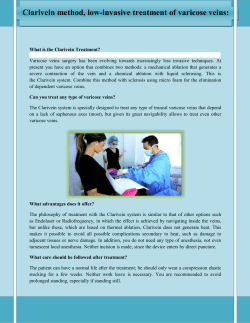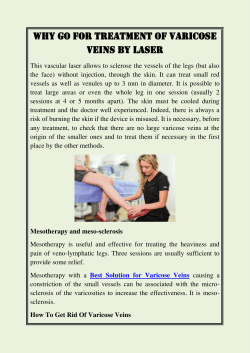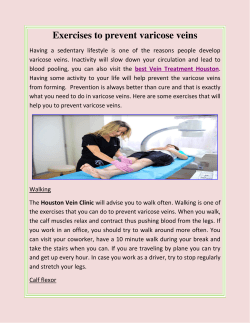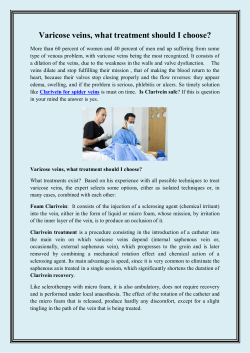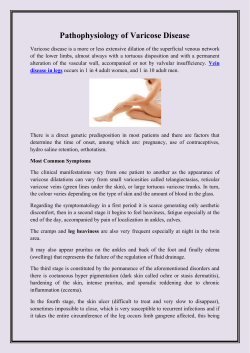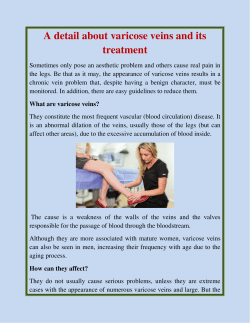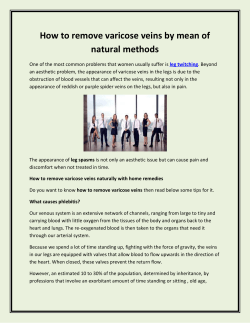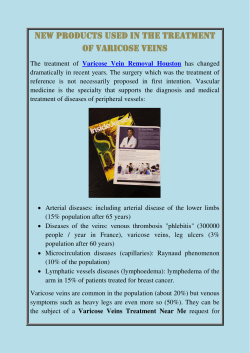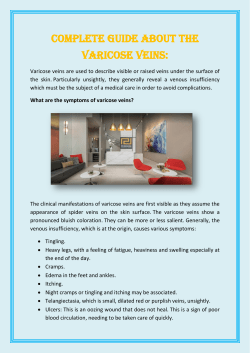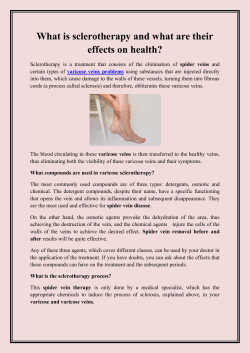
Varicose Vein disorder symptoms and treatment
Varicose Vein disorder symptoms and treatment Outpatient methods, minimally invasive Varicose Vein Treatment, are divided into 2 main categories: 1. Varicose Vein Treatment methods – Thermal ablation It uses a thermal agent (heat) that can be produced by the use of steam, radio frequency or laser, for the obliteration (closure) of varicose veins. These methods are performed under ultrasound guidance and are minimally invasive. Local anaesthesia or sedation with the same day activity resuming is required. Steam method Laser method Radio frequency method 2. Varicose veins treatment methods – Chemical ablation Injection of a sclerosing substance (by injection or catheter) into varicose veins which causes a chemically induced irritation, the venous walls swell and thus the vein is obliterated (closed) Microsclerotherapy – for obliteration - closure of small and superficial varicose veins (venectasias and certain telangiectasias); Echolithic sclerotherapy - UGS; ALPHA method - catheter foam under ultrasound guidance; Treatment of varicose veins by these methods is achieved by obliterating, that is, closing, these veins (varicose veins) with the help of a thermal or chemical agent. This stops the blood flow in the varicose veins, which is absorbed by the body over time and completely disappears. The blood flow is redirected through the healthy veins of the affected leg. These methods can be used alone or in combination with other methods within the clinic, depending on the patient's diagnostic landscape, so that the end result is as good as possible. In the case vascular surgeons are trained to use all the minimal-invasive methods, the option of combinations being discussed with the patient before the medical act. Varicose veins treatment methods – Surgical treatment of varicose veins: Stripping is the most widespread method used these days. Requires general anaesthesia or spinal anaesthesia, recovery time 7-14 days, hematomas may occur, in some cases even infections of the incisions, as well as postoperative pain. Other risk factors for the development of varicose veins are: Intense physical exertion Practicing sports that involve sudden starts and stops (tennis, for example) Hot baths and prolonged state in saunas (determines the expansion of blood vessels due to heat) Removing unwanted hair with hot wax Uncomfortable shoes - too high or too narrow heel Smoking and excessive coffee or alcohol consumption Long-term contraceptive administration (due to hormone content) Treatment For Varicose Veins: How we recognize them? Varicose veins are recognized by their appearance. They appear on the legs and are prominent, being easy to observe on the surface of the skin. They are inflamed and have a purple, blue color. In some cases, the area around them is inflamed, and the skin is dry and stretched. In some cases, eggplants appear around the prominent veins. Beyond the characteristic aspect, there are Varicose Veins Symptoms such as: Feeling tired, heavy feet Pains, stings, tingling in the legs Bleeding from varicose veins Varicose Veins Before And After: Varicose veins have multiple stages of development, and at first they can only look like a spider's web, the other symptoms appear later. At the same time, depending on their lifestyle, they may improve or, on the contrary, may worsen. In the early stage, varicose veins are not accompanied by pain and are not very prominent.
© Copyright 2026
